Abstract
Objective
Moyamoya disease (MMD) is a progressive steno-occlusive cerebrovascular phenomenon with unknown pathogenesis. Considering the abundance of articles addressing Moyamoya disease, a detailed analysis concerning the publication trends is of paramount importance. The aim of the study is to report the current knowledge of the top-100 most cited articles on Moyamoya disease in the literature.
Methods
A non-time restricted keyword-based search was performed in June 2020 using the Scopus database. The search keywords included the following: “Moyamoya”, “Moyamoya disease”, and “Moyamoya syndrome”. The search result was used to rank the articles based on their citation count. The top-100 most-cited articles were obtained and classified into seven categories.
Results
A total of 3,543 articles on Moyamoya disease were published between 1955 and 2020. The Top-100 articles were published between 1977 and 2016 with a total of 16,119 citations, per year, and 7.23% rate of self-citation. The 1990s was the most productive decade (N=42). The most contributing country to the list was Japan (N=60). Stroke was the most active journal (N=23). Houkin, K., a Japanese neurosurgeon, was the most prolific author (N=15).
Conclusions
Moyamoya disease has been extensively investigated in the literature throughout the years. The majority of articles published in the literature were addressing the surgical management and clinical outcome. Authors from neurosurgical backgrounds were the most active contributors to the field of Moyamoya disease.
Moyamoya disease (MMD) is an uncommon cerebrovascular abnormality with a pathognomonic feature of progressive occlusion of supraclinoid internal carotid artery (ICA). Takeuchi and Shimizu were the first to describe this abnormality in 1957 as bilateral hypoplasia of the ICAs where Kudo T. was the first to describe it as a spontaneous occlusion of the circle of Willis in 1968 [24,41]. Moyamoya, a Japanese term, was first introduced to the medical literature by Suzuki and his colleague Takaku in 1969 [40]. The term characterizes the obscured hazy angiographic appearance of collaterals “MoyaMoya vessels (; puff of smoke)” resulting from insufficiency in the circle of Willis [35,40]. The epidemiological patterns of Moyamoya reveal its predominance in Eastern Asia [20].
Bimodal peaks of age have been noted with the disease distribution, particularly in the first and fourth decades, and it is slightly more common in females [20]. Although more than half a century has passed since the first time a Moyamoya case was reported in 1957, the etiology of Moyamoya is not yet well established, and many incongruities in its pathogenesis are still unresolved [41]. The diagnostic criteria for MMD according to Fukui et al. involved three criteria: 1) The stenotic occlusion of the terminal ICA and the proximal portion of anterior and/or middle cerebral arteries, 2) Abnormal vascular network evidenced in the arterial phase in proximity to the occlusion, and 3) Bilateral involvement [6]. The clinical presentation of MMD is variable depending on the age of the patient which include: transient ischemic attacks, ischemic stroke, hemorrhagic stroke, headache, and cognitive dysfunction [43].
Bibliometric analysis is a detailed statistical tool that has been widely used to review scientific research in various fields [12,34,38]. Recently, bibliometric analyses, in the form of citations count, have been used as indicators of performance in the scientific literature [1]. Bibliometric evaluation of neurosurgical publications has previously been published on pediatric neurosurgery, acoustic neuroma, intracerebral hemorrhage and meningioma [2,3,33]. To the best of our knowledge, however, a bibliometric analysis has never been performed on MMD.
As bibliometric analyses have been conducted to assess the intellectual work in the academic fields, a comprehensive bibliometric analysis is required to assess the current publication trends on MMD. They help identify the metrics, trends, as well as the patterns of publications. This will enable the readership of the journals to gain evidence-based knowledge in the field of MMD. In the current study, we aim to conduct a bibliometric analysis to evaluate and assess the influence of the published literature in Moyamoya disease/syndrome by examining the most-cited articles in the literature.
This bibliometric review study on the most-cited articles on MMD was performed using the Scopus database. A non-time restricted keyword-based search was performed in June 2020. The search keywords included the following keywords: “Moyamoya”, “Moyamoya disease”, and “Moyamoya syndrome”. The identified articles were ranked from highest to lowest based on their citation count and the most-cited top 100 articles were chosen for further examination. The citation per year (CY) was used to minimize time-bias, as some articles were recently published without having enough time to accumulate citations over the years. In reviewing the top-100 articles, we collected pertinent information to our review which included thirteen parameters.
The article-based parameters (title, year of publication, country of origin, contributing authors, speciality of the most contributing authors, contributing institutes, and publishing journal), and bibliometric-based parameters (citation count, citation per year, author’s H-index, Journal’s Source Normalized Impact Per Paper [SNIP], Journal’s SCImago Journal Rank [SJR], and the Journals Impact Factor [IF]). The categorization of the top-100 articles, after analyzing the studied entities in the most-cited articles, has classified the studies into seven categories. This included; Epidemiological studies, pathophysiological studies, clinical studies, clinicoradiological studies, radiological studies, guidelines studies, and surgical management studies. Based on the identified journals of contribution, a quantified method was used to rank the most contributing journals based on the number of publications per journal. A journal with five or more publications from the top 100 list were considered to be highly contributing to the most-cited articles on MMD.
The Scopus based search has identified 3,543 published articles on Moyamoya disease between 1955 and 2020. The Top-100 articles were published between 1977 and 2016 (Table 1). The top-100 received a total of 16,119 citations and 161.19 citations per year, with a 7.23% rate of self-citation for all contributing authors. Studying the publications trends shows that the 1990s was the most active decade with 42 highly cited publications on MMD (Fig. 1). Studies on the surgical management and clinical outcome were the two most prevalent study categories (Fig. 2).
The most contributing country to the list was Japan by producing 60 articles from the list (Fig. 3). The Tohoku University School of Medicine was the most conducive institute to the list by contributing to 12 articles (Fig. 4). The Stroke Journal was the most active journal in terms of participation by publishing 23 articles from the top-100 list (Fig. 5). Houkin, K., a Japanese neurosurgeon, was the most prolific author to the top-100 list by authoring 15 articles from the list (Fig. 6). The number 1 article was authored by Scott R.M., and Smith E.R., which was published in the New England Journal of Medicine in 2009 entitled “Moyamoya disease and moyamoya syndrome”. The article received a total of 763 citations and 69.36 citation per year.
The publications on Moyamoya disease in the late 70s focused on the surgical management. The authors targeted the effectiveness of anastomotic procedures (i.e., superficial temporal-middle cerebral artery STA-MCA), as a treatment modality for ischemic and/or neurological deficits. Additionally, the first reported series on encephalo-myo-synangiosis for patients with MMD was performed. In the 80s, however, the clinicoradiological aspect of MMD gained more interest, along with the surgical aspect. The angiographic findings of MMD were frequently correlated with clinical features of the disease. In the 90s, most publications were comparatively assessing direct vs. indirect revascularization techniques and the efficacy of STA-MCA vs. Encephalo-Duro-Arterio-Myo-Synangiosis (EDAMS) for the treatment of MMD. In the twenty-first century, MMD was being addressed from all aspects including the surgical, clinical, clinicoradiological, pathophysiological, radiological, epidemiological, and guideline-related.
In the top-100 list, the article with the highest citation count (CC) was published in the New England Journal of Medicine (2009) by Scott R.M. and Smith E.R [36]. The article received a total of 763 CC and 69.3 citations per year (CY) [36]. The authors have comprehensively reviewed Moyamoya disease and syndrome from a demographic, pathogenetic, and treatment perspectives [36]. In children and adults, MMD has been recognized to be the culprit of stroke [36]. A prompt identification of the disease early in the course to facilitate therapy is essential to achieve excellent clinical outcome [36]. In patients with MMD, treatment with revascularization surgery has been shown to be effective in the prevention of stroke [36].
The second highest cited article in our list was published in the Stroke (Journal) in 1983 by Suzuki J. and Kodama N, with 590 CC and 15.9 CY [39]. The authors retrospectively evaluated 100 cases of MMD between 1961 and 1980 [39]. They have outlined the reason for the various clinical presentations in children vs. adults, emphasized on the angiographic findings of MMD, and its possible pathophysiology [39]. Differences in the clinical features and radiological findings between children and adults were observed [39]. In children, recurrent events of sudden hemiplegia have been commonly noted. In adults, however, intracranial hemorrhage was a common clinical presentation [39].
A quarter of the publications were targeting the surgical management of MMD. Fung et al. published an article (ranked 26th) with 186 CC and 12.4 CY [7]. The authors have performed a systematic review of the literature (1966-2004) discussing revascularization techniques and outcomes in children [7]. Of note, 87% of the patients experienced symptomatic benefit, defined by complete resolution, reduction of the symptoms or remained asymptomatic, for a mean of approximately five years of follow-up postoperatively [7]. Another article (ranked 14th) was published by Miyamoto and his colleagues with 229 CC and 38.1 CY [31]. The authors conducted a prospective randomized controlled trial to investigate the feasibility of extracranial-intracranial bypass in reducing the incidence of rebleeding [31]. In their randomized controlled trial (JAM trial), it was concluded that the direct revascularization, in hemorrhagic Moyamoya, can improve the prognosis and lessen the rate of rebleeding after five years of follow-up, although the evidence is arguable [4,31].
To date, there are no well-settled recommendations of a particular type of revascularization over another. Direct techniques, first performed by Kikuchi and Karasawa among Moyamoya disease cases in 1973, have shown preferable prognosis outcomes but debatable rates of complications and longer operative time than indirect techniques [5,19,30]. Karasawa et al. introduced revascularization in Moyamoya disease in 1980 with which it can be utilized as an option in cases where extracranial-intracranial anastomosis is difficult to perform [17,30]. Karasawa et al. published their article (ranked 83rd) in 1993 which has received 94 CC and 3.4 CY [18]. The authors investigated the application of omental transplantation to manage ischemic changes in the vascular territories of the anterior/middle/posterior arteries [18]. Neurological improvement was noted in patients with omental transplantation [18]. The authors recommended omental transplantation to manage ischemic changes in the anterior/posterior cerebral arteries territories [18].
Articles in the clinical category, comprising 25% of the top-100 list, peaked in 1985-2016. Kobayashi et al. published an article (ranked 46th) with 124 CC and 6.2 CY [22]. The main aim of their study was to assess the long-term follow-up and natural history of hemorrhagic Moyamoya disease in 42 patients [22]. In their cohort, the occurrence of rebleeding in hemorrhagic MMD was associated with worse prognosis [22]. Clinically, MMD can present with different clinical manifestations including; stroke (hemorrhagic/ischemic), epilepsy, cognitive impairment, and/or headaches [21,32]. Although it is largely influenced by geographical differences and age; ischemic presentation is common among the pediatric population [28]. In adults, hemorrhagic presentation is more prevalent in east Asian countries [32]. Yet, ischemic stroke is more prevalent in other populations [23]. Additionally, it is worth noting that MMD can be isolated or present as a syndrome accompanying other conditions (e.g., sickle cell disease) [11,28]. The disease course, in both adults and pediatric age groups, is progressive and patients are likely to experience deteriorating neurological and cognitive functions, if left untreated [15,22,27].
The clinicoradiological category gained popularity between the years of 1983 to 2012. Hallemeier et al. in their article (ranked 18th) concluded that North American patients with bilateral involvement of MMD and ischemic symptoms are rendered susceptible to recurrent strokes [10]. On the other hand, Kuroda et al. published an article (ranked 37th) with 143 CC and 17.8 CY [26]. The authors conducted a multi-center study to investigate the clinical and radiological features of asymptomatic MMD [26]. Their findings demonstrated that asymptomatic MMD could potentially cause lethal neurological sequelae such as ischemic and hemorrhagic strokes [26]. Consequently, such patients require a periodic clinical assessment to further delineate their long-term outcome [26].
Articles addressing the pathogenesis of MMD were published between 1981-2012. The key area of interest was on the histopathological features, molecular aspect, and genetic/inheritance patterns of MMD. The highly characteristic patterns of the disease has led the investigations of underlying genetic association to start in the late 1990s [13]. Proportion of 6% and 10%, in the US and Japanese population of Moyamoya disease affected individuals, are found to have a 1st degree family relative with the same condition [6,37]. RNF213 gene, non-exclusively, found to be attributed to the susceptibility of its development in some Asian populations [16,29]. Guo et al. published an article (ranked 7th) with 284 CC and 25.8 CY [9]. The authors investigated possible mutations contributing to the development of MMD [9]. Their study findings revealed that single-gene mutations can cause diffuse vascular diseases that may play a central role in the pathogenesis of MMD [9]. Similarly, Kamada et al. published an article (ranked 8th) with 277 CC and 30 CY. The authors performed a genome-wide analysis of 72 patients with MMD and subsequently compared them to 45 patients in the control group [16]. They have demonstrated that RNF213 gene serves as the first gene implicated in the pathogenesis of MMD [16].
The majority of publications in the radiological category peaked in 1994 to 2014. The key topics during that era were utility and efficacy of magnetic resonance imaging (MRI), digital subtraction angiography (DSA), and positron emission tomography (PET). Ikezaki et al. published an article (ranked 44th) with 126 CC and 4.6 CY [14]. The authors conducted a peri-operative study to investigate the role of positron emission tomography (PET) scan in oxygen metabolism of pediatric MMD patients [14]. PET scans were essential to investigate cerebral metabolism and circulation in the evaluation of pediatric patients with MMD [14]. Contrarily, Yamada et al. published an article (ranked 63rd) with 108 CC and 4.3 CY [42]. The authors evaluated the role of MRI and magnetic resonance angiography (MRA) in describing MMD [42]. Their study findings revealed that the combination of MRI and MRA yields excellent results in the identification of steno-occlusive disease and moyamoya vessels [42].
Articles investigating the epidemiological perspective of MMD peaked in publication between 1992-2008, with most studies being conducted in Japan. Kuriyama et al. conducted a questionnaire-based survey, (ranked 11th) with 258 CC and 21.5 CY, to estimate the prevalence of MMD [25]. They have proposed that the prevalence rate of MMD in Japan has escalated in recent years, due to the diagnosis of newly confirmed cases [25]. In the article of Goto and Yonekawa (ranked 61st) published in 1992 with 109 CC and 3.8 CY, the worldwide geographical distribution of MMD was commonly observed in Asia and non-Caucasian populations [8].
Two articles comprehensively investigated the guidelines implicated in the diagnosis and management of MMD. The first guideline article was published in 1997 with 502 CC and 21.8 CY. The second article was published in 2012, to which it received 348 CC and 43.5 CY. Interestingly, the two articles ranked 4th and 5th in the top-100 list of the present study, although they were published 15 years apart.
This bibliometric analysis is not free from inherent limitations. The citation received for old citation overtime can lead to citation over representation and this time-bias can be minimized by using the citation per year which was used in our review. The fact that citation-based analysis of articles does not represent the scientific value of the article and the proper use of bibliometrics with the conjunction of peer reviewed articles will provide a holistic view in any studied entity. The Scopus database has some limitations in which they are improving over time. The detailed citation coverage for articles published before 1970 is not included in their bibliometric tools which can under represent the citation count for articles published prior to that time. Additionally, the rate of self-citation can insignificantly inflate the citations of articles. However, self-citation was minor in our bibliometric review on MMD.
The majority of publications investigating Moyamoya disease were targeting the surgical and clinical aspects. In the management of MMD, the effectiveness of anastomotic procedures has gained acceptance, especially in the treatment of ischemic and neurological deficits. The top two most cited articles were published, as reviews, in the New England Journal of Medicine and Stroke. Neurosurgeons were contributing to most of the publications in the top-100 list. In the 21st century, authors were investigating and publishing articles on MMD from all clinical perspectives. The present bibliometric analysis highlighted the most reputable key articles to researchers in the field of Moyamoya disease.
REFERENCES
1. Aksnes DW, Langfeldt L, Wouters P. Citations, citation indicators, and research quality: An overview of basic concepts and theories. SAGE Open. 2019; Jan-Mar. 9:1–17.

2. Alfaifi A, AlMutairi O, Allhaidan M, Alsaleh S, Ajlan A. The top 50 most-cited articles on acoustic neuroma. World Neurosurg. 2018; Mar. 111:e454–64.

3. Almutairi O, Albakr A, Al-Habib A, Ajlan A. The top-100 most-cited articles on meningioma, in world neurosurgery. World Neurosurg. 2017; Nov. 107:1025–32.
4. Aoki N. Cerebrovascular bypass surgery for the treatment of Moyamoya disease: unsatisfactory outcome in the patients presenting with intracranial hemorrhage. Surg Neurol. 1993; Nov. 40(5):372–7.

5. Fujimura M, Kaneta T, Mugikura S, Shimizu H, Tominaga T. Temporary neurologic deterioration due to cerebral hyperperfusion after superficial temporal artery-middle cerebral artery anastomosis in patients with adult-onset moyamoya disease. Surg Neurol. 2007; Mar. 67(3):273–82.

6. Fukui M, Kono S, Sueishi K, Ikezaki K. Moyamoya disease. Neuropathology. 2000; Sep. 20 Suppl:S61–4.

7. Fung LWE, Thompson D, Ganesan V. Revascularisation surgery for paediatric moyamoya: A review of the literature. Child’s Nerv Syst. 2005; May. 21(5):358–64.

8. Goto Y, Yonekawa Y. Worldwide distribution of moyamoya disease. Neurol Med Chir (Tokyo). 1992; Nov. 32(12):883–6.

9. Guo DC, Papke CL, Tran-Fadulu V, Regalado ES, Avidan N, Johnson RJ, et al. Mutations in smooth muscle alpha-actin (ACTA2) cause coronary artery disease, stroke, and Moyamoya disease, along with thoracic aortic disease. Am J Hum Genet. 2009; May. 84(5):617–27.

10. Hallemeier CL, Rich KM, Grubb RL Jr, Chicoine MR, Moran CJ, Cross DT 3rd, et al. Clinical features and outcome in North American adults with moyamoya phenomenon. Stroke. 2006; Jun. 37(6):1490–6.

11. Hankinson TC, Bohman LE, Heyer G, Licursi M, Ghatan S, Feldstein NA, et al. Surgical treatment of moyamoya syndrome in patients with sickle cell anemia: outcome following encephaloduroarteriosynangiosis. J Neurosurg Pediatr. 2008; Mar. 1(3):211–6.

12. Hennessey K, Afshar K, MacNeily AE. The top 100 cited articles in urology. J Can Urol Assoc. 2009; Aug. 3(4):293–302.

13. Ikeda H, Sasaki T, Yoshimoto T, Fukui M, Arinami T. Mapping of a familial moyamoya disease gene to chromosome 3p24.2-p26. Am J Hum Genet. 1999; Feb. 64(2):533–7.

14. Ikezaki K, Matsushima T, Kuwabara Y, Suzuki SO, Nomura T, Fukui M. Cerebral circulation and oxygen metabolism in childhood moyamoya disease: A perioperative positron emission tomography study. J Neurosurg. 1994; Dec. 81(6):843–50.

15. Ikezaki K. Rational approach to treatment of moyamoya disease in childhood. J Child Neurol. 2000; May. 15(5):350–6.

16. Kamada F, Aoki Y, Narisawa A, Abe Y, Komatsuzaki S, Kikuchi AK, et al. A genome-wide association study identifies RNF213 as the first Moyamoya disease gene. J Hum Genet. 2011; Jan. 56(1):34–40.

17. Karasawa J, Kikuchi H, Kawamura J, Sakai T. Intracranial transplantation of the omentum for cerebrovascular moyamoya disease: A two-year follow-up study. Surg Neurol. 1980; Dec. 14(6):444–9.
18. Karasawa J, Touho H, Ohnishi H, Miyamoto S, Kikuchi H. Cerebral revascularization using omental transplantation for childhood moyamoya disease. J Neurosurg. 1993; Aug. 79(2):192–6.

19. Kazumata K, Ito M, Tokairin K, Ito Y, Houkin K, Nakayama N, et al. The frequency of postoperative stroke in moyamoya disease following combined revascularization: a single-university series and systematic review. J Neurosurg. 2014; Aug. 121(2):432–40.

20. Kim JS. Moyamoya disease: Epidemiology, clinical features, and diagnosis. J Stroke. 2016; Jan. 18(1):2–11.

21. Kleinloog R, Regli L, Rinkel GJ, Klijn CJ. Regional differences in incidence and patient characteristics of moyamoya disease: a systematic review. J Neurol Neurosurg Psychiatry. 2012; May. 83(5):531–6.

22. Kobayashi E, Saeki N, Oishi H, Hirai S, Yamaura A. Longterm natural history of hemorrhagic moyamoya disease in 42 patients. J Neurosurg. 2000; Dec. 93(6):976–80.
23. Kraemer M, Heienbrok W, Berlit P. Moyamoya disease in Europeans. Stroke. 2008; Dec. 39(12):3193–200.

24. Kudo T. Spontaneous occlusion of the circle of Willis. A disease apparently confined to Japanese. Neurology. 1968; May. 18(5):485–96.

25. Kuriyama S, Kusaka Y, Fujimura M, Wakai K, Tamakoshi A, Hashimoto S, et al. Prevalence and clinicoepidemiological features of moyamoya disease in Japan: findings from a nationwide epidemiological survey. Stroke. 2008; Jan. 39(1):42–7.
26. Kuroda S, Hashimoto N, Yoshimoto T, Iwasaki Y; Research Committee on Moyamoya Disease in Japan. Radiological findings, clinical course, and outcome in asymptomatic moyamoya disease: results of multicenter survey in Japan. Stroke. 2007; May. 38(5):1430–5.
27. Kuroda S, Ishikawa T, Houkin K, Nanba R, Hokari M, Iwasaki Y. Incidence and clinical features of disease progression in adult moyamoya disease. Stroke. 2005; Oct. 36(10):2148–53.

28. Lee S, Rivkin MJ, Kirton A, deVeber G, Elbers J; International Pediatric Stroke Study. Moyamoya disease in children: Results from the international Pediatric Stroke Study. J Child Neurol. 2017; Oct. 32(11):924–9.

29. Liu W, Morito D, Takashima S, Mineharu Y, Kobayashi H, Hitomi T, et al. Identification of RNF213 as a susceptibility gene for moyamoya disease and its possible role in vascular development. PLoS One. 2011; 6(7):e22542.

30. Matsushima T, Inoue K, Kawashima M, Inoue T. History of the development of surgical treatments for moyamoya disease. Neurol Med Chir (Tokyo). 2012; 52(5):278–86.

31. Miyamoto S, Yoshimoto T, Hashimoto N, Okada Y, Tsuji I, Tominaga T, et al. Effects of extracranial-intracranial bypass for patients with hemorrhagic moyamoya disease: Results of the Japan adult moyamoya trial. Stroke. 2014; May. 45(5):1415–21.
32. Nah HW, Kwon SU, Kang DW, Ahn JS, Kwun BD, Kim JS. Moyamoya disease-related versus primary intracerebral: Hemorrhage location and outcomes are different. Stroke. 2012; Jul. 43(7):1947–50.
33. Nasir SAR, Gilani JA, Fatima K, Faheem U, Kazmi O, Siddiqi J, et al. Top 100 most-cited articles on spontaneous intracerebral hemorrhage: A bibliometric analysis. World Neurosurg. 2018; Feb. 110:445–9.

34. Pagni M, Khan NR, Cohen HL, Choudhri AF. Highly cited works in radiology: the top 100 cited articles in radiologic journals. Acad Radiol. 2014; Aug. 21(8):1056–66.
35. Poor G, Gacs G. The so called ‘Moyamoya disease’. J Neurol Neurosurg Psychiatry. 1974; Apr. 37(4):370–7.
36. Scott RM, Smith ER. Moyamoya disease and moyamoya syndrome. N Engl J Med. 2009; Mar. 19. 360(12):1226–37.

37. Scott RM, Smith JL, Robertson RL, Madsen JR, Soriano SG, Rockoff MA. Long-term outcome in children with moyamoya syndrome after cranial revascularization by pial synangiosis. J Neurosurg. 2004; Feb. 100(2 Suppl Pediatrics):142–9.

38. Shuaib W, Acevedo JN, Khan MS, Santiago LJ, Gaeta TJ. The top 100 cited articles published in emergency medicine journals. Am J Emerg Med. 2015; Aug. 33(8):1066–71.

40. Suzuki J, Takaku A. Cerebrovascular “Moyamoya” disease. Disease showing abnormal net-like vessels in base of brain. Arch Neurol. 1969; Mar. 20(3):288–99.
41. Takeuchi K, Shimizu K. Hypogenesis of bilateral internal carotid arteries. No to Shinkei. 1957; 9:37–43.
42. Yamada I, Suzuki S, Matsushima Y. Moyamoya disease: comparison of assessment with MR angiography and MR imaging versus conventional angiography. Radiology. 1995; Jul. 196(1):211–8.

43. Zhang H, Zheng L, Feng L. Epidemiology, diagnosis and treatment of Moyamoya disease. Exp Ther Med. 2019; Mar. 17:1977–84.
Fig. 1.
Publication trends of the top-100 most cited articles on Moyamoya disease between 1977-2016.
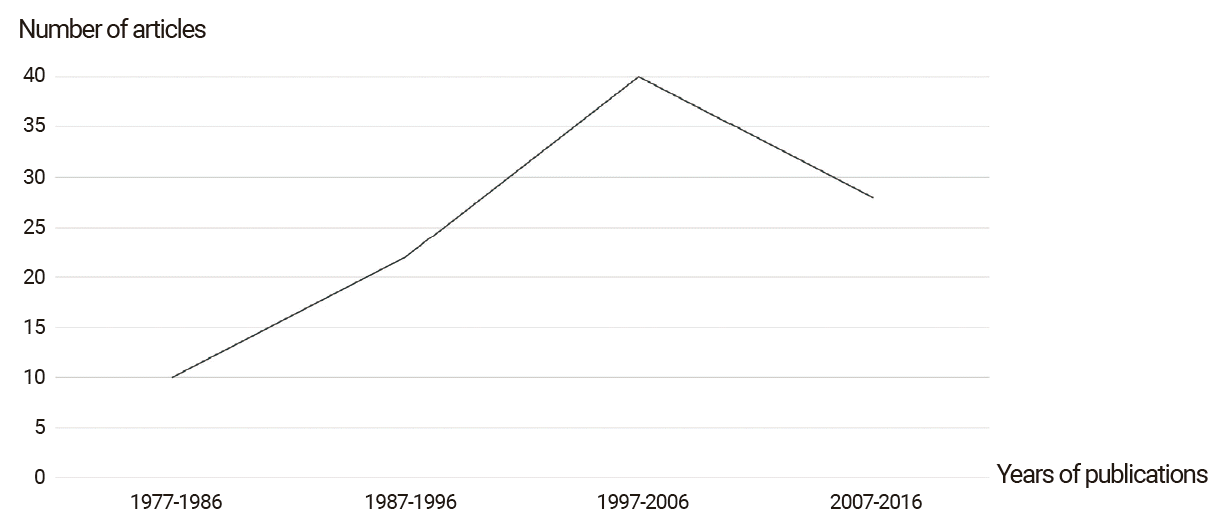
Fig. 5.
The top journals publishing articles on Moyamoya disease and their corresponding impact factor, Journal’s SNIP, Journal’s SJR. SNIP, Source Normalized Impact Per Paper; SJR, Journal’s SCImago Journal Rank.
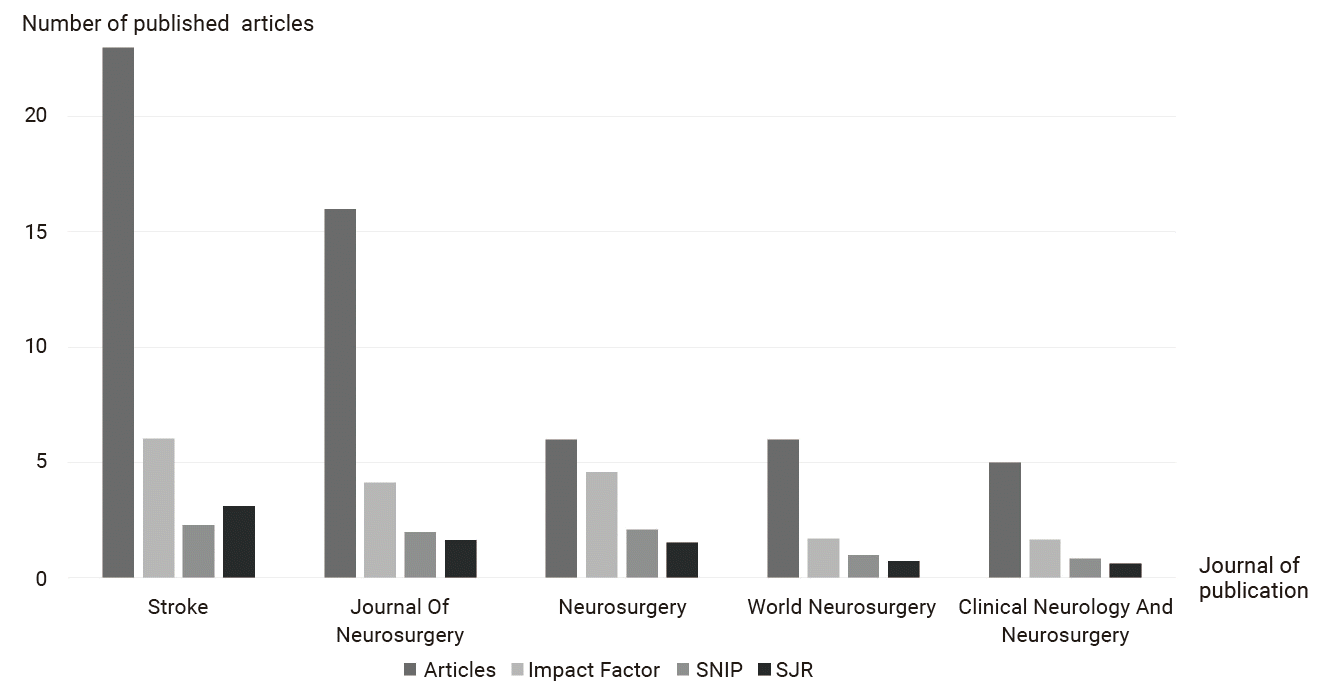
Table 1.
The top-100 most cited articles on Moyamoya disease ranked by their corresponding citation count




 PDF
PDF Citation
Citation Print
Print



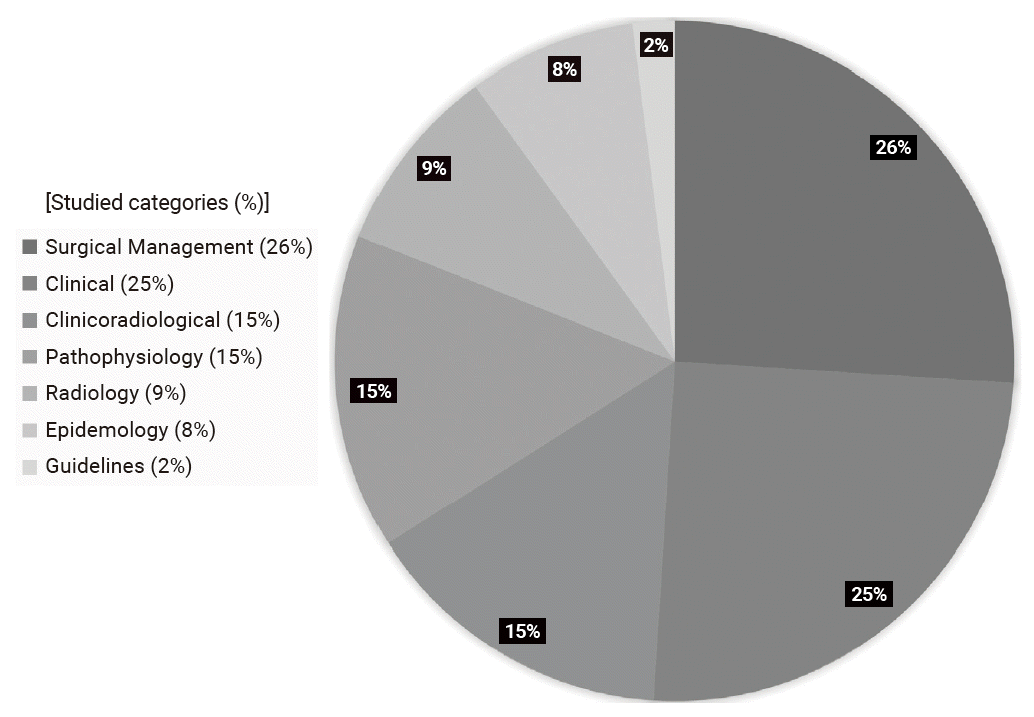
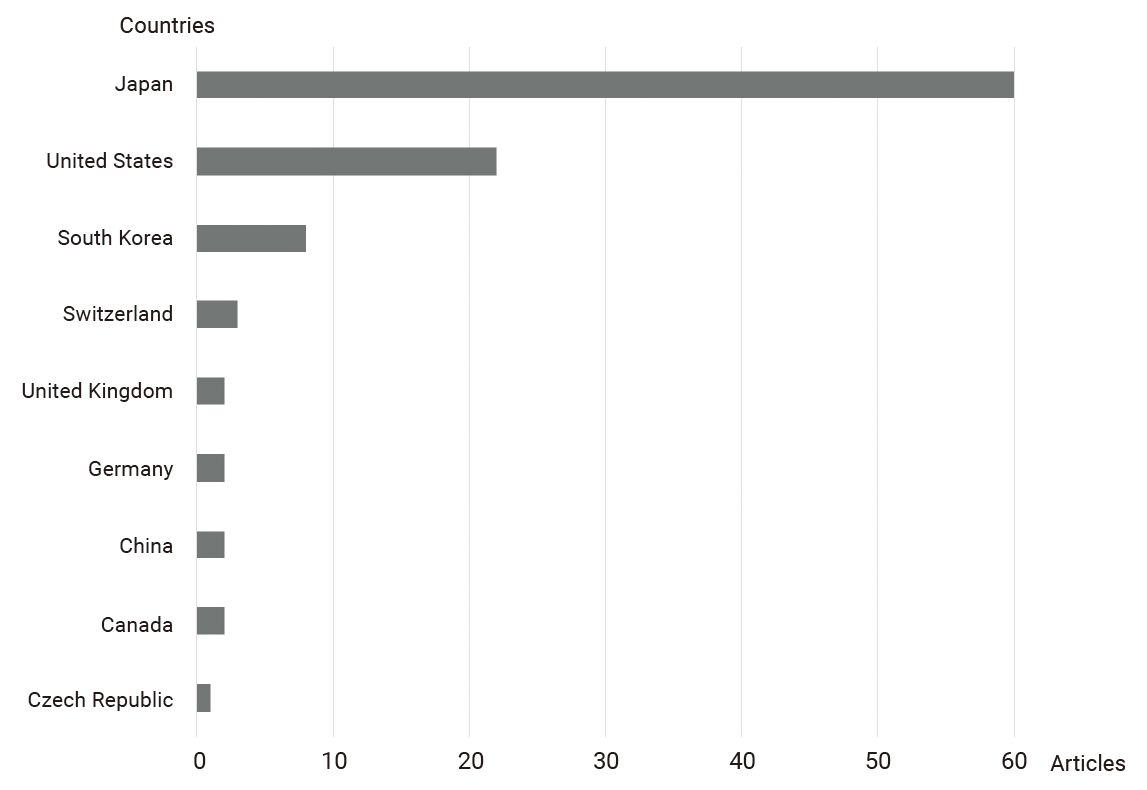
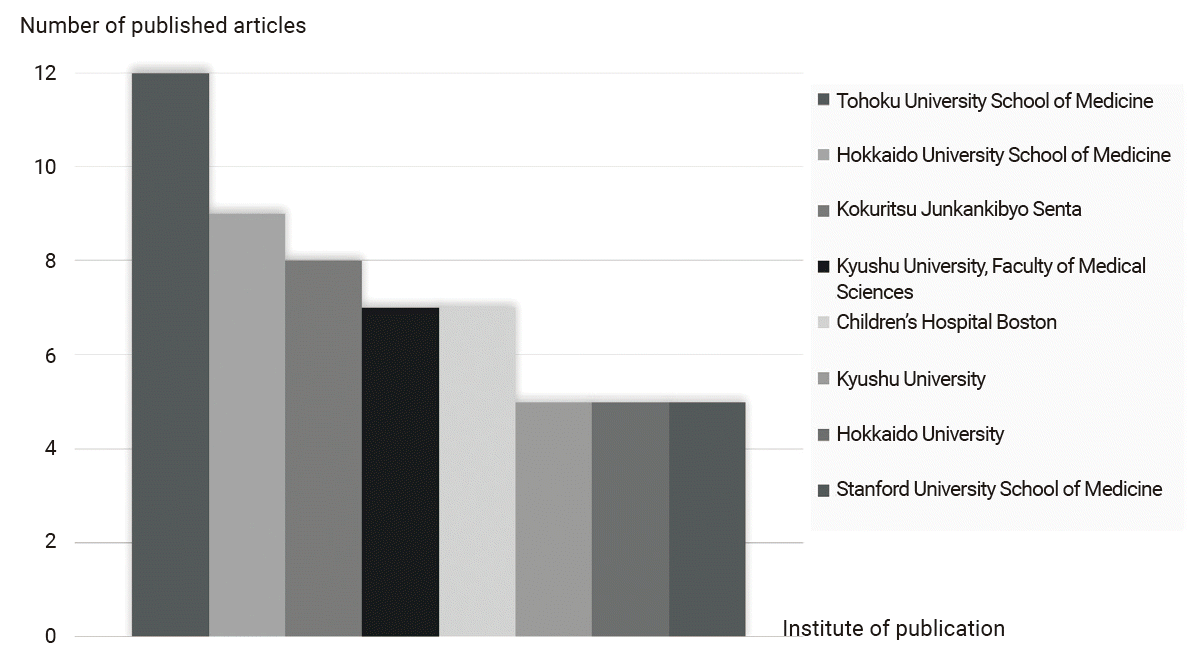
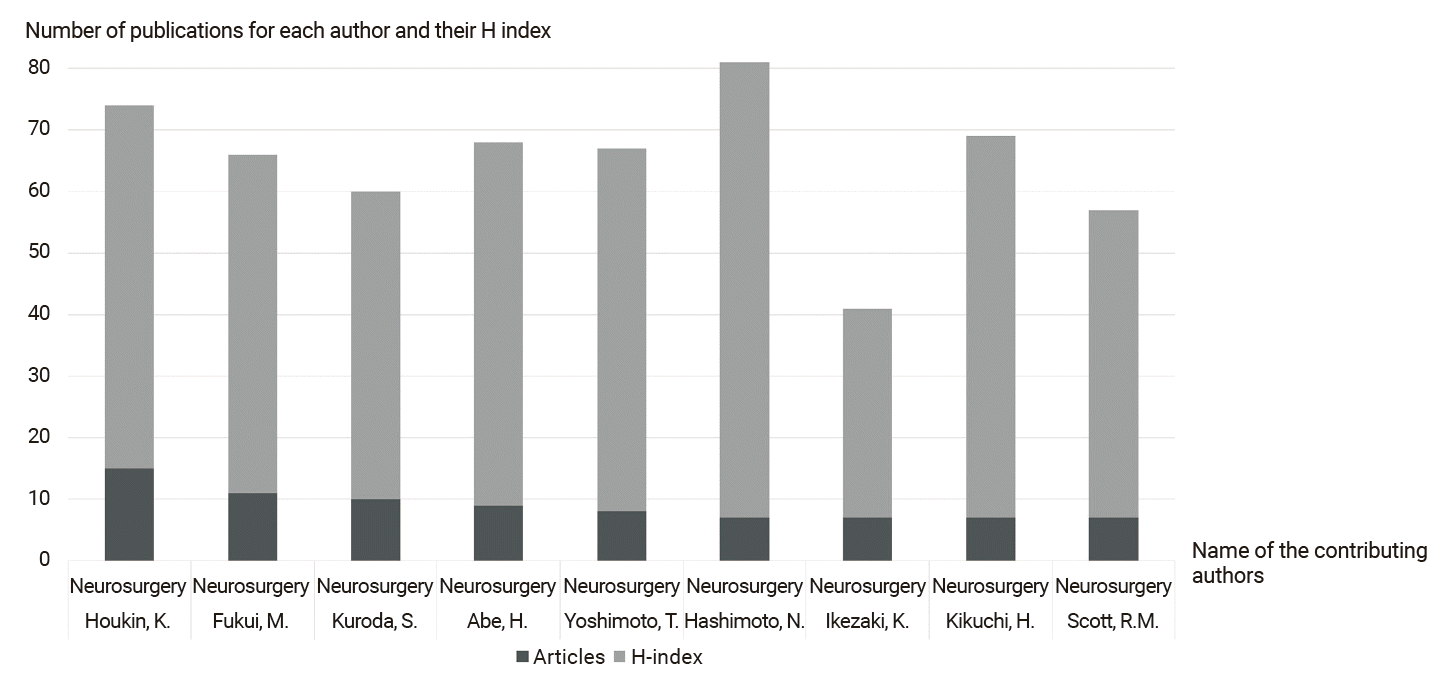
 XML Download
XML Download